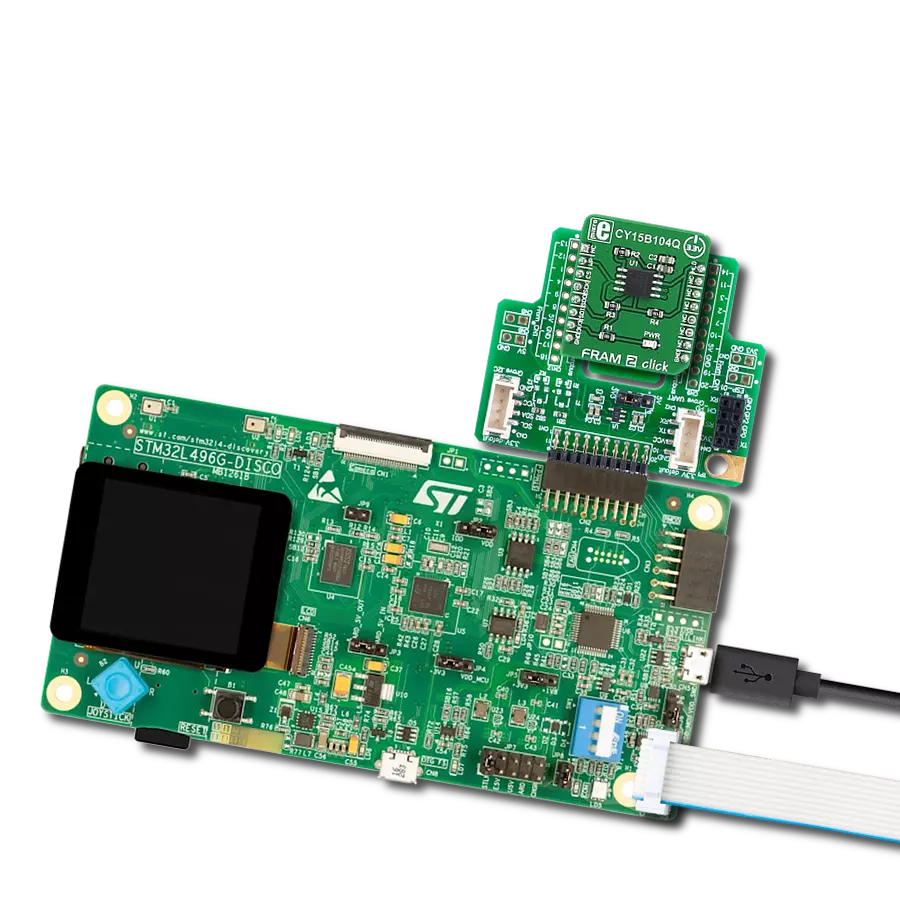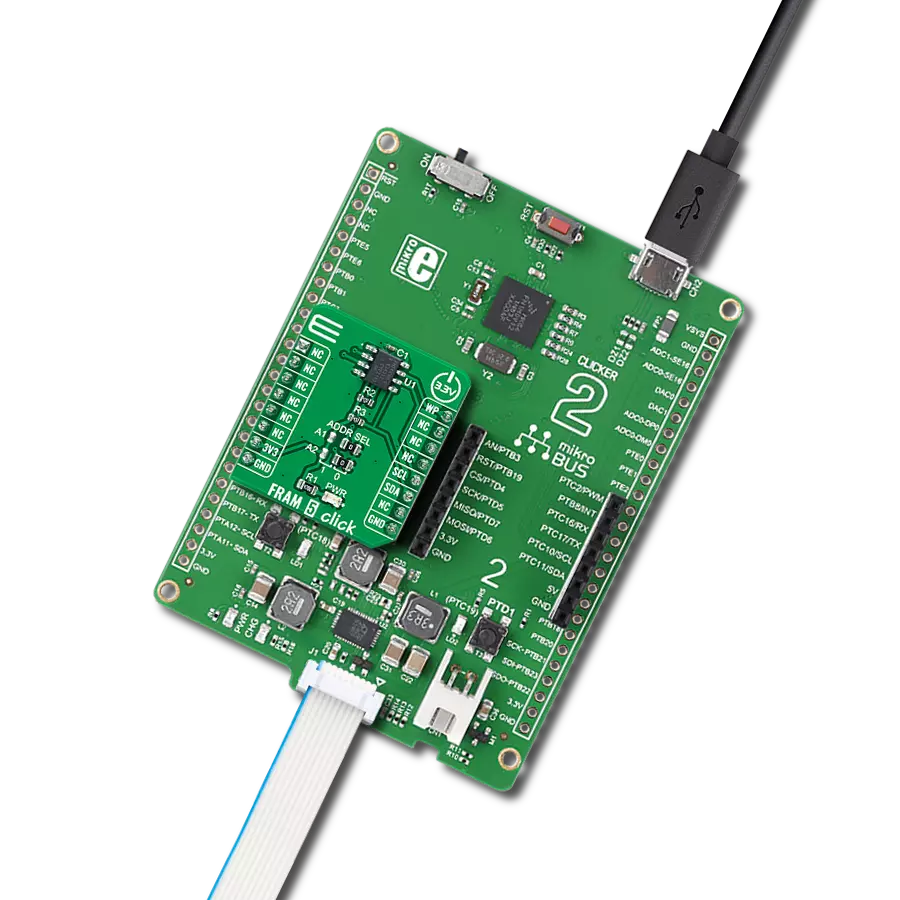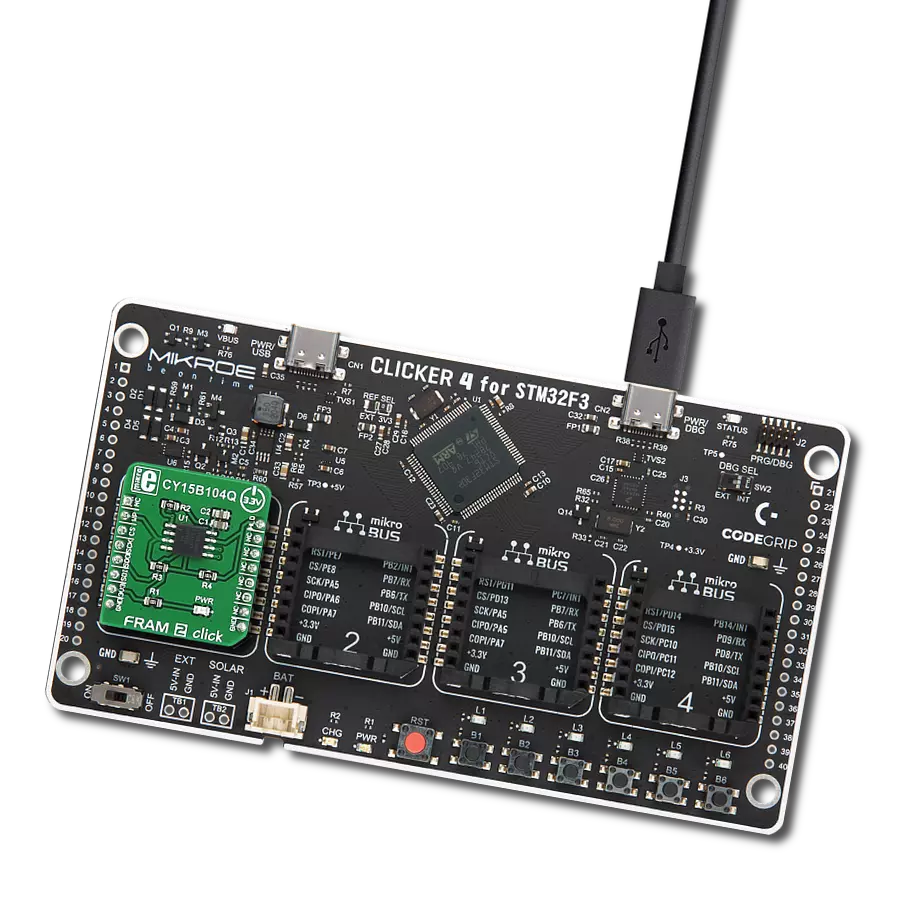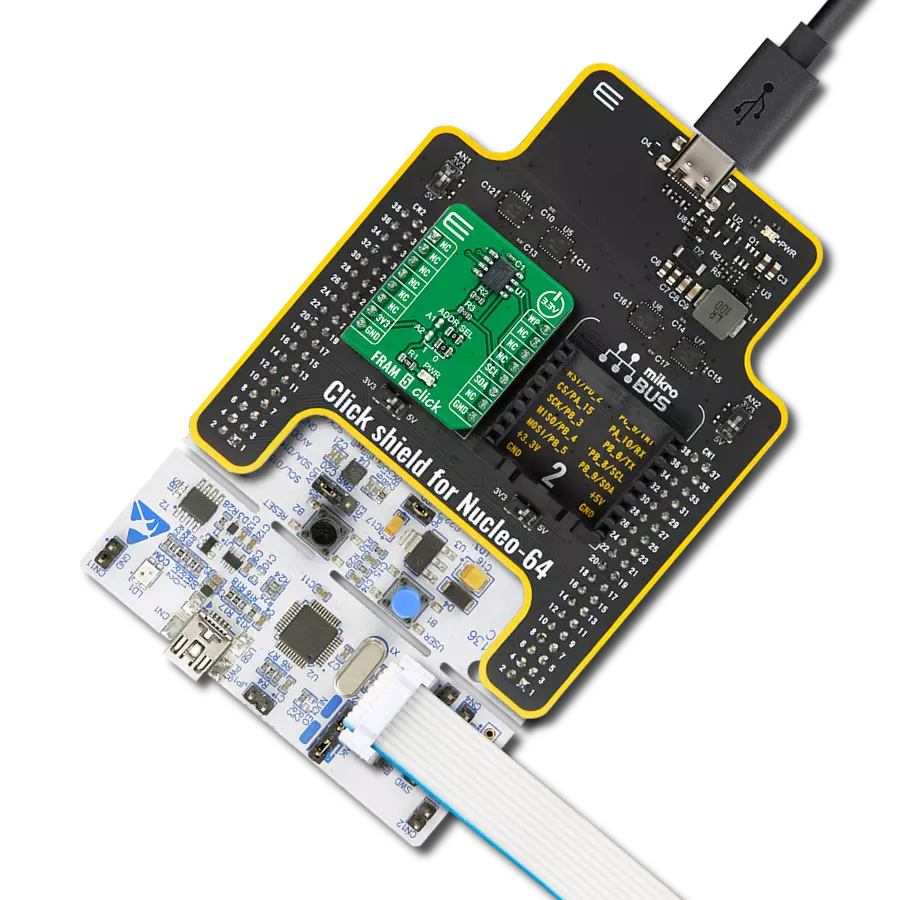Ultra-reliable lightning-fast memory storage for your projects!
A
A
Hardware Overview
How does it work?
FRAM Click is based on the MB85RS256A, a memory FRAM from Fujitsu. It can retain data without a backup battery, as SRAM needs. Although the FRAM is still being developed, this company provided a very reliable and fast FRAM module that can write data at bus speed, has an extremely high endurance of 10 billion read/write cycles, and a fast SPI interface. When using the Writer to an array instruction, it is possible to write the whole array, which is an obvious advantage
over the traditional EEPROM. The FRAM memory does not use pages because the memory is written faster than the SPI bus can deliver new information (the data is written at bus speed). Therefore, no buffering is required, and the whole array can be sequentially written. FRAM Click uses a standard 4-Wire SPI interface to communicate with the host MCU supporting 25MHz of maximum operating frequency and an SPI 0 (0, 0) and SPI 3 (1, 1) modes. The MB85RS256A includes the write
protection of the specific parts or the whole memory array, which can be accessed over the WP pin. The hold HLD pin interrupts serial input/output without deselecting the chip. This Click board™ can be operated only with a 3.3V logic voltage level. The board must perform appropriate logic voltage level conversion before using MCUs with different logic levels. Also, it comes equipped with a library containing functions and an example code that can be used as a reference for further development.
Features overview
Development board
PIC18F57Q43 Curiosity Nano evaluation kit is a cutting-edge hardware platform designed to evaluate microcontrollers within the PIC18-Q43 family. Central to its design is the inclusion of the powerful PIC18F57Q43 microcontroller (MCU), offering advanced functionalities and robust performance. Key features of this evaluation kit include a yellow user LED and a responsive
mechanical user switch, providing seamless interaction and testing. The provision for a 32.768kHz crystal footprint ensures precision timing capabilities. With an onboard debugger boasting a green power and status LED, programming and debugging become intuitive and efficient. Further enhancing its utility is the Virtual serial port (CDC) and a debug GPIO channel (DGI
GPIO), offering extensive connectivity options. Powered via USB, this kit boasts an adjustable target voltage feature facilitated by the MIC5353 LDO regulator, ensuring stable operation with an output voltage ranging from 1.8V to 5.1V, with a maximum output current of 500mA, subject to ambient temperature and voltage constraints.
Microcontroller Overview
MCU Card / MCU
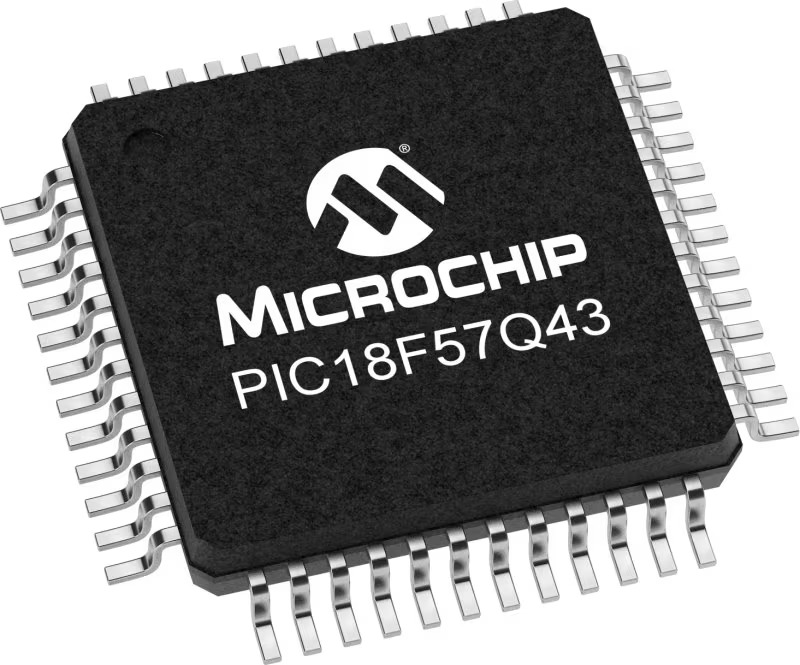
Architecture
PIC
MCU Memory (KB)
128
Silicon Vendor
Microchip
Pin count
48
RAM (Bytes)
8196
You complete me!
Accessories
Curiosity Nano Base for Click boards is a versatile hardware extension platform created to streamline the integration between Curiosity Nano kits and extension boards, tailored explicitly for the mikroBUS™-standardized Click boards and Xplained Pro extension boards. This innovative base board (shield) offers seamless connectivity and expansion possibilities, simplifying experimentation and development. Key features include USB power compatibility from the Curiosity Nano kit, alongside an alternative external power input option for enhanced flexibility. The onboard Li-Ion/LiPo charger and management circuit ensure smooth operation for battery-powered applications, simplifying usage and management. Moreover, the base incorporates a fixed 3.3V PSU dedicated to target and mikroBUS™ power rails, alongside a fixed 5.0V boost converter catering to 5V power rails of mikroBUS™ sockets, providing stable power delivery for various connected devices.
Used MCU Pins
mikroBUS™ mapper
Take a closer look
Click board™ Schematic

Step by step
Project assembly
Software Support
Library Description
This library contains API for FRAM Click driver.
Key functions:
fram_write_enable- This function sends write enable command to the chipfram_read- This function reads sequential memory locations to bufferfram_write- This function writes to sequential memory locations from buffer.
Open Source
Code example
The complete application code and a ready-to-use project are available through the NECTO Studio Package Manager for direct installation in the NECTO Studio. The application code can also be found on the MIKROE GitHub account.
/*!
* \file
* \brief Fram Click example
*
* # Description
* This app writing data to Click memory.
*
* The demo application is composed of two sections :
*
* ## Application Init
* Initialization device.
*
* ## Application Task
* Writing data to Click memory and displaying the read data via UART.
*
* \author MikroE Team
*
*/
// ------------------------------------------------------------------- INCLUDES
#include "board.h"
#include "log.h"
#include "fram.h"
// ------------------------------------------------------------------ VARIABLES
static fram_t fram;
static log_t logger;
// ------------------------------------------------------ APPLICATION FUNCTIONS
void application_init ( void )
{
log_cfg_t log_cfg;
fram_cfg_t cfg;
/**
* Logger initialization.
* Default baud rate: 115200
* Default log level: LOG_LEVEL_DEBUG
* @note If USB_UART_RX and USB_UART_TX
* are defined as HAL_PIN_NC, you will
* need to define them manually for log to work.
* See @b LOG_MAP_USB_UART macro definition for detailed explanation.
*/
LOG_MAP_USB_UART( log_cfg );
log_init( &logger, &log_cfg );
log_info( &logger, "---- Application Init ----" );
// Click initialization.
fram_cfg_setup( &cfg );
FRAM_MAP_MIKROBUS( cfg, MIKROBUS_1 );
fram_init( &fram, &cfg );
fram_erase_all( &fram );
Delay_ms ( 1000 );
}
void application_task ( void )
{
char wr_data[ 10 ] = { 'M', 'i', 'k', 'r', 'o', 'E', 13, 10, 0 };
char rd_data[ 20 ] = { 0 };
uint8_t i = 0;
log_printf( &logger, "Writing MikroE to Fram memory, from address 0x0150: \r\n" );
fram_write( &fram, 0x0150, &wr_data[ 0 ], 9 );
Delay_ms ( 1000 );
log_printf( &logger, "Reading 9 bytes of Fram memory, from address 0x0150: \r\n" );
fram_read( &fram, 0x0150, &rd_data[ 0 ], 9 );
log_printf( &logger, "Data read: %s \r\n", rd_data );
Delay_ms ( 1000 );
}
int main ( void )
{
/* Do not remove this line or clock might not be set correctly. */
#ifdef PREINIT_SUPPORTED
preinit();
#endif
application_init( );
for ( ; ; )
{
application_task( );
}
return 0;
}
// ------------------------------------------------------------------------ END
Additional Support
Resources
Category:FRAM


























